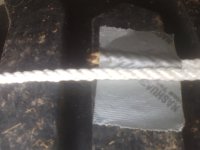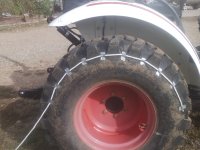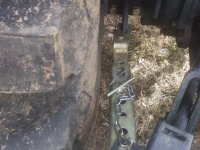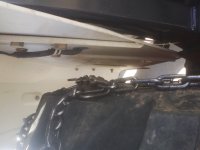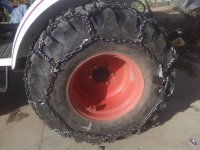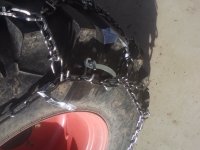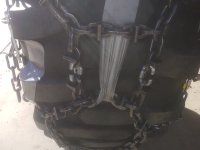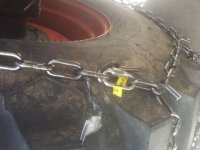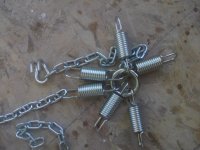Cord
Veteran Member
I've built chains in the past and have modified several sets as well. Generally it's been hard to find affordable 3/8" link chains for 10x16 and 12x16 tires so I've taken to buying tractor chains and then modifying them to fit.
Generally when I make tire chains I don't use a tape measure. There is enough error in the link spacing and tire shape that the chains can be very hard to accurately measure. Instead, I'll dismount the tire and then drape the chains across the tread to determine what the cross chain length should be. Don't forget to allow for the side clips. I then flip the tire on it's side and do my best to mock up the side chain. The side chain need to be set far enough down the sidewall so the chains can't twist around sideways. This can be tricky because of the take-up mechanism so I will add 6-8 links to the calculated ideal length. I'd prefer to throw away a couple of waste links instead of throwing away several feet of chain because I cut it too short. It's much easier to install chains and keep them tight if you put adjusters on both the inside and the outside of the tire.
The job will require a set of tire chain plyers. I can't see how you'd do it without them.
As to installing, I've found the best way to install chains is with the tires up in the air. You can now slide the chains around and actually get them to fit the tire. It's not the only way, it's just the way that seem to work best for me. As for tensioning, I use several bungee cords positioned across the tire to keep the chains tight. I don't bother with cords on the inside because clearances are often too tight. I tried a set of spring adjusters and they seem to be lasting better than the bungie cords. Didn't care for the chain system that was used to set the spring tension, but unrefined in my opinion. After running the chains for a little while I'll go back and set the adjusters one link shorter. After the second tensioning they seem to run out just fine for the rest of the season.
Generally when I make tire chains I don't use a tape measure. There is enough error in the link spacing and tire shape that the chains can be very hard to accurately measure. Instead, I'll dismount the tire and then drape the chains across the tread to determine what the cross chain length should be. Don't forget to allow for the side clips. I then flip the tire on it's side and do my best to mock up the side chain. The side chain need to be set far enough down the sidewall so the chains can't twist around sideways. This can be tricky because of the take-up mechanism so I will add 6-8 links to the calculated ideal length. I'd prefer to throw away a couple of waste links instead of throwing away several feet of chain because I cut it too short. It's much easier to install chains and keep them tight if you put adjusters on both the inside and the outside of the tire.
The job will require a set of tire chain plyers. I can't see how you'd do it without them.
As to installing, I've found the best way to install chains is with the tires up in the air. You can now slide the chains around and actually get them to fit the tire. It's not the only way, it's just the way that seem to work best for me. As for tensioning, I use several bungee cords positioned across the tire to keep the chains tight. I don't bother with cords on the inside because clearances are often too tight. I tried a set of spring adjusters and they seem to be lasting better than the bungie cords. Didn't care for the chain system that was used to set the spring tension, but unrefined in my opinion. After running the chains for a little while I'll go back and set the adjusters one link shorter. After the second tensioning they seem to run out just fine for the rest of the season.
